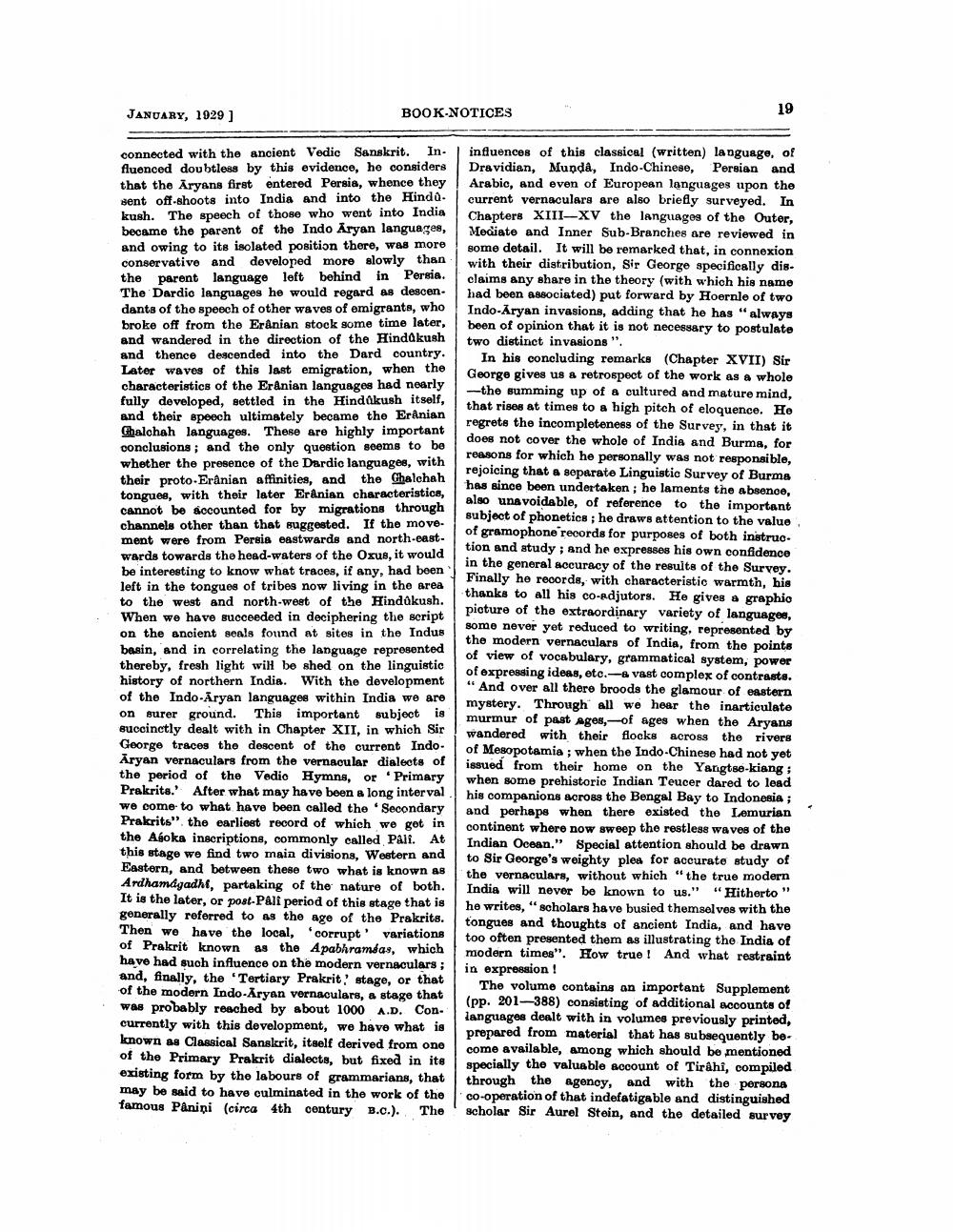________________
19
JANUARY, 1929 ]
BOOK-NOTICES
connected with the ancient Vedic Sanskrit. In fluenced doubtless by this evidence, ho considers that the Aryans first entered Persia, whence they sent off-shoots into India and into the Hindo. kush. The speech of those who went into India became the parent of the Indo Aryan languages, and owing to its isolated position there, was more conservative and developed more slowly than the parent language left behind in Persia. The Dardio languages he would regard as descen. dants of the speech of other waves of emigrants, who broke off from the Erânian stock some time later, and wandered in the direction of the Hindakush and thence descended into the Dard country. Later waves of this last emigration, when the characteristics of the Eranian languages had nearly fully developed, settled in the Hindokush itself, and their speech ultimately became the ErAnian Ghalohah languages. These are highly important conclusions; and the only question seems to be whether the presence of the Dardic languages, with their proto-Erânian affinities, and the Chalchah tongues, with their later Eranian characteristics, cannot be sccounted for by migrations through channels other than that suggested. If the movement were from Persia eastwards and north-eastwards towards the head-waters of the Oxus, it would be interesting to know what traces, if any, had boen left in the tongues of tribes now living in the area to the west and north-west of the Hindůkush. When we have succeeded in deciphering the script on the ancient seals found at sites in the Indus barin, and in correlating the language represented thereby, fresh light will be shed on the linguistic history of northern India. With the development of the Indo-Aryan languages within India we are on surer ground. This important subject is succinctly dealt with in Chapter XII, in which Sir George traces the descont of the current IndoAryan vernaculars from the vernacular dialects of the period of the Vedic Hymns, or Primary Prakrits. After what may have been a long interval we come to what have been called the Secondary Prakrits" the earliest record of which we get in the Agoka inscriptions, commonly called Pali. At this stage we find two main divisions, Western and Eastern, and between these two what is known as Ardhamdgadhe, partaking of the nature of both. It is the later, or post-Pali period of this stage that is generally referred to as the age of the Prakrits. Then we have the local, corrupt' variations of Prakrit known as the Apabhramdas, which have had such influence on the modern vernaculars; and, finally, the Tertiary Prakrit,' stage, or that of the modern Indo-Aryan vernaculars, a stage that was probably reached by about 1000 A.D. Con. currently with this development, we have what is known as Classical Sanskrit, itself derived from one of the Primary Prakrit dialects, but fixed in its existing form by the labours of grammarians, that may be said to have culminated in the work of the famous Paniņi (circa 4th century B.C.). The
influences of this classical (written) language, of Dravidian, Munda, Indo-Chinese, Persian and Arabio, and even of European languages upon the current vernaculars are also briefly surveyed. In Chapters XIII-XV the languages of the Outer, Mediate and Inner Sub-Branches are reviewed in some detail. It will be remarked that, in connexion with their distribution, Sir George specifically disclaims any share in the theory (with which his name had boon associated) put forward by Hoernle of two Indo-Aryan invasions, adding that he has "always been of opinion that it is not necessary to postulate two distinct invasions".
In his concluding remarks (Chapter XVII) Sir George gives us a retrospect of the work as a whole
-the summing up of a cultured and mature mind, that rises at times to a high pitch of eloquence. Ho regrets the incompleteness of the Survey, in that it does not cover the whole of India and Burma, for reasons for which he personally was not responsible, rejoicing that a separate Linguistic Survey of Burma has since been undertaken; he laments the absence, also unavoidable, of reference to the important subject of phonetics; he draws attention to the value of gramophone records for purposes of both instruc. tion and study; and he expresses his own confidence in the general accuracy of the results of the Survey. Finally he records, with characteristic warmth, his thanks to all his co-edjutors. He gives a graphio picture of the extraordinary variety of languages, some never yet reduced to writing, represented by the modern vernaculars of India, from the points of view of vocabulary, grammatical system, power of expressing ideas, etc.-& vast complex of contrasts. "And over all there broods the glamour of eastern mystery. Through all we hear the inarticulate murmur of past ages-of ages when the Aryans wandered with their flocks across the rivers of Mesopotamia ; when the Indo-Chinese had not yet issued from their home on the Yangtse-kiang; when some prehistoric Indian Teucer dared to lead his companions across the Bengal Bay to Indonesia; and perhaps when there existed the Lemurian continent where now sweep the restless waves of the Indian Ocean." Special attention should be drawn to Sir George's weighty plea for accurate study of the vernaculars, without which "the true modern India will never be known to us." "Hitherto" he writes, "scholars have busied themselves with the tongues and thoughts of ancient India, and have too often presented them as illustrating the India of modern times". How true! And what restraint in expression!
The volume contains an important Supplement (pp. 201-388) consisting of additional accounts of languages dealt with in volumes previously printed, prepared from material that has subsequently become available, among which should be mentioned specially the valuable account of Tirahi, compiled through the agency, and with the persona co-operation of that indefatigable and distinguished scholar Sir Aurel Stein, and the detailed survey




